For Those Who Came In Late: We continue our STARMAN discussion where we left off last week: after a lengthy sojourn through space, followed by a speedy induction into the revived Justice Society of America, Jack Knight has returned to his beloved hometown Opal City, which despite the prediction of its destruction in a previous issue, appears as bright and beautiful as ever upon Jack’s arrival. At least at first…
If, as I suggested a couple weeks back, the STARMAN of “The Stars My Destination” seemed like a different series than what had come before it, that it has to be remarked that “Grand Guignol” felt very much like a return to greatness for the series, or at least as close as one could get without the return of Jack Knight’s co-creator Tony Harris. Handling the writing solo once more is James Robinson, who seems to be revitalized here with the return to Opal City, and at the opportunity to finally harvest all of the dramatic seeds he had planted for the previous 60 issues. After so many issues in space, in which the heart of the book seemed almost drained out of it, suddenly the omniscient, poetic narration that had characterized the series so well in its first 50 issues was back. For example, take a look at this page from STARMAN #61, spotlighting two new arrivals to the Opal, Ralph “The Elongated Man” Dibny and the mysterious Black Condor:
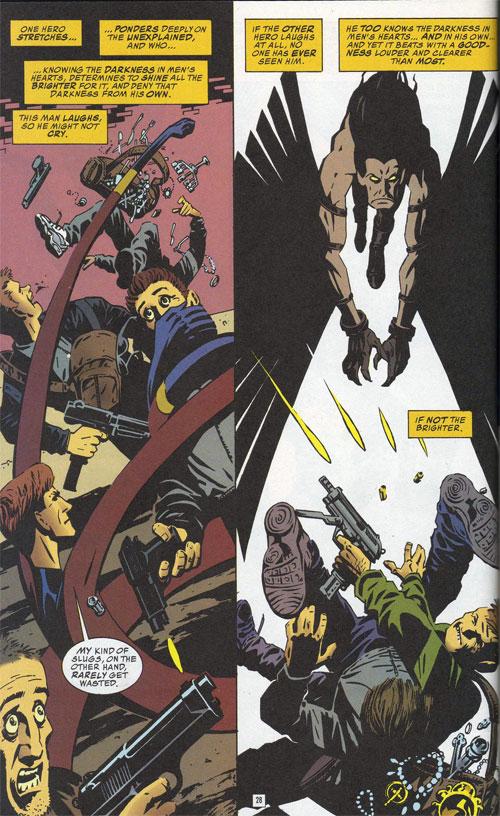
Rising to the level of Robinson’s writing was Peter Snejberg, who was now being allowed to ink his own work, returning a moody, dark feel to the series that hadn’t been seen since Tony Harris’ departure. While there was still a cartoony lightness to the work that remained appealing, Snejberg’s heavy inks and increased use of shadow (seen below in this page of Ted Knight’s reminiscing) grounded the story in darkness and thematically linked it to the early days of the series.

As “Grand Guignol” opened with the prologue in STARMAN #61…
Wait a minute. First things first. What the hell does “Grand Guignol” mean, anyway?
For those of you not up on your 19th-century Franco-European theatrical history (and shame on you if you’re not), the Grand Guignol was a small theatre in Paris, France, that specialized in extremely naturalistic horror plays with shocking endings and bloodily graphic climaxes. Opening its doors in 1894 and running continuously for the next seven decades, it wasn’t at all uncommon to see startlingly realistic murders, rapes, assaults and other forms of mayhem lovingly replicated on stage in gruesome detail — in its heyday, it’s said that the theatre’s director judged the success of its productions by how many people in the audience fainted. The theatre continued its productions until closing its doors in 1962, with the Grand Guignol’s final director claiming that the all-too-real horrors of the Holocaust had rendered them obsolete.
What does this have to do with the story at hand? Well, besides playing off Opal City’s previously established emigrated French heritage, the title also sets the tone for what’s to come: dark days of horror and fear for the Opal and her residents. The story began for a returned Jack in STARMAN #61 (January 2000), who not long after his arrival back home is briefed by an unexpected ally, Ralph Dibny, The outlook is quite not good: a series of murders that points to the Shade as the culprit, a whole bunch of missing people, including Bobo Bennetti and Matt and Hope O’Dare, and an uneasy quiet laying over the city, despite rumors of numerous criminals, super-powered and not, arriving in the Opal.

Elsewhere, another new arrival to the Opal is running for her life, having arrived at her predecessor’s behalf to try and help the Shade, a decision that looks as though it was a fatal one:

Also missing, Jack learns from his fortune-teller friend Charity, is Mason O’Dare and Jack’s own beloved Sadie. Sadie had enlisted Charity’s help in contacting the spirit of Jon Valor, whose name Jack had promised to help clear. Sadie promised to help, and soon after disappeared, with Mason vanishing not long after while searching for her.
There is some good news, though, as Jack finds his father safe and sound, at Opal’s new Starman Museum.

A change of clothes later, and a familiar sight is seen streaking across Opal’s skies:

In one page, Robinson and Snejbjerg quickly explain away Jack’s previously published adventures on Earth…

And then, Jack is met with the horrific sight of explosions rocking through the city. In a bitterly ironic touch, it’s the exact same perspective that a relieved Jack saw when he first returned to Earth:
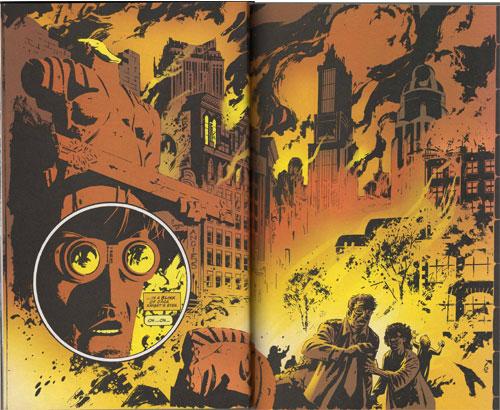
In a way, the delay of the assault on Opal gave it even more power, as the reader was expecting it on Jack’s return, and instead was allowed to let that feeling of dread build before the attack.
Robinson structured the story arc in such way that it was continually looking back on itself, with each large revelation then sparking a flashback revealing how such a thing came to be. For example, the issue following the explosion flashed back to the days before Jack had returned from space, showing us in closer detail the arrival of the Phantom Lady and Adam Strange to Opal, the capture of Sadie and Jon Valor’s spirit by The Shade (who it seemed had indeed gone bad) and his minions the Bodines (remember them from Will Payton’s “Times Past” issue?), and most shocking yet, revealed who was responsible for the disappearance of Matt and Hope O’Dare: their own brother Barry.

As Opal City crumbles around them, we see Ralph Dibny desperately trying to find his wife, a tender little scene which now seems all the more bittersweet given the characters’ unfortunate fate in the years to come:
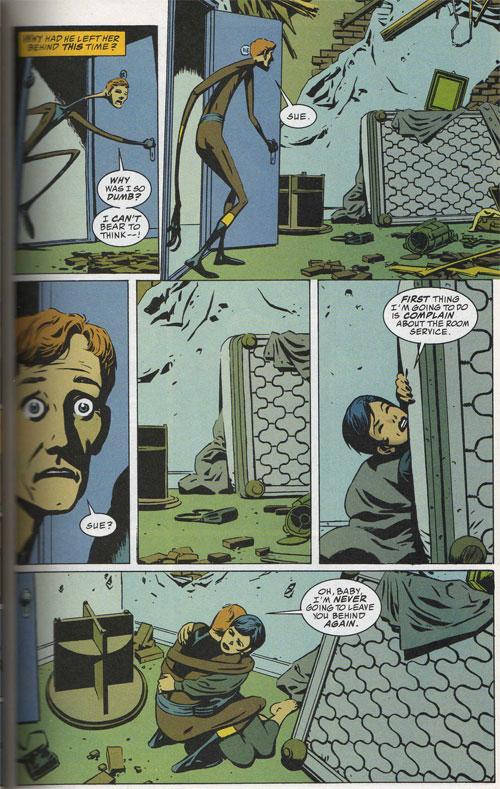
Robinson, by the way, makes excellent use of Ralph and Sue Dibny in this series, writing them better than anyone since their original run in DETECTIVE COMICS. I particularly love this moment, perfectly captured by Peter Snejbjerg:

Meanwhile, the Shade proclaims his innocence to the Black Condor, explaining the man he thinks is really responsible, a dwarf named Culp who gained immortality and shadow powers in the same unexplained moment and manner as the Shade, and with whom the Shade had battled over the decades.
And by the end of STARMAN #63, things were getting progressively worse. The returned Dr. Phosphorous was about to make another attempt on Ted Knight’s life, while the Shade somehow makes use of Jon Valor’s captured spirit to create a shadowy shroud over the Opal, enclosing it completely. Jack attempts to make a call to his new teammates in the JSA for help, but it’s too late.

All the cards are laid on the table in the fourth chapter of “Grand Guignol” in STARMAN #65, in which Clarence O’Dare and Opal’s police go to war in the streets of Opal City with the Shade’s army of criminals, which includes as its generals the Mist, the now savage Solomon Grundy, the Bodines, Crusher (the mindless muscleman way back from Jack’s adventure at the circus), the Spider (another Ludlow taking up his father’s Shade-hating mantle), and somehow, even the Ragdoll, long thought dead at the hands of Ted Knight, Alan Scott and Jay Garrick. And of course, Dr. Phosphorous, who finds once again that taking out Ted Knight is a task much easier said than done.
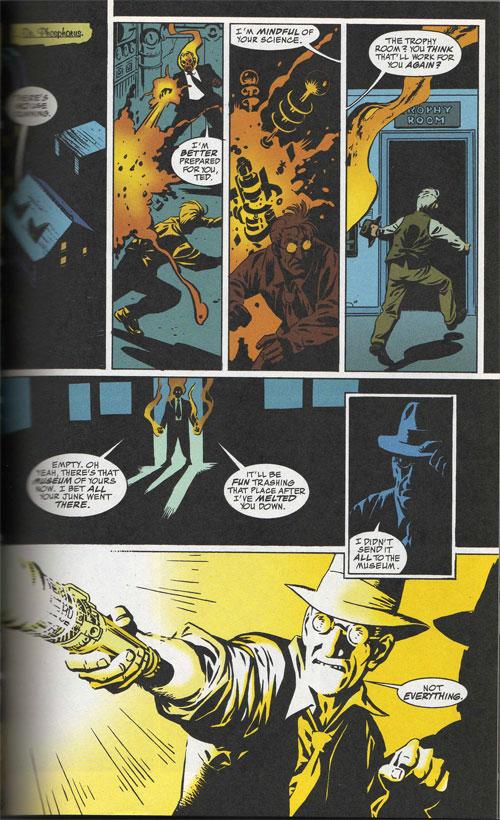
Only an hour after he’d taken control of the city, the Shade takes to Opal’s airwaves, with his army arrayed in front of him and his enemies in chains before him.

The Shade informs the city of its fate — to be looted of every drop of its wealth and then consigned to shadowy oblivion within his infinite blackness. The Shade also takes the opportunity to call out Opal’s protector. In an effort to lure Jack Knight to him, the Shade first reveals that he has Sadie and intends her harm, and second reveals the body of the man in whose care Jack left Opal City: Bobo Bennetti:
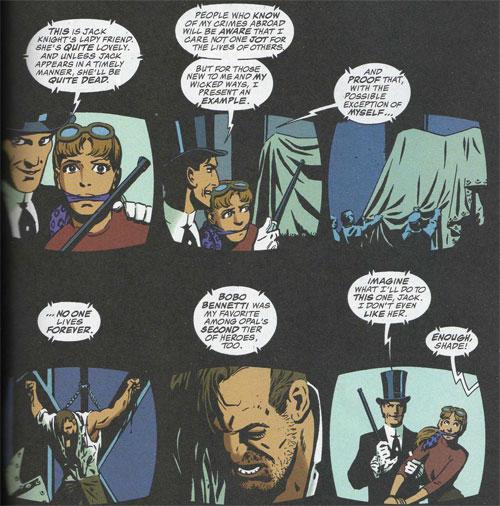
Jack arrives almost immediately, and is instantly set upon by his collected enemies. Although he’s bound to fall and does, Jack fights valiantly with his Cosmic Rod before it loses power under Opal’s now starless sky, just as the Shade mysteriously collapses in shadowy convulsions, with the true mastermind behind Opal’s capture emerging from his body like a butterfly from a chrysalis.

The Shade, it turns out, was innocent. It had in fact been the dwarfish Simon Culp, controlling the Shade from within his own body, behind the Shade’s villainous acts of late. STARMAN #66 took a look back at the long relationship between the Shade and Culp, at the years of the two trying to kill each other, and at the explosion during their duel in WW II-era London that somehow fused them together, completely unbeknownst to the Shade. As a result, when the Shade grew fatigued, Culp was able to usurp control of his body, which he would sometimes use to commit heinous crimes, and sometimes use just to make the Shade look foolish.
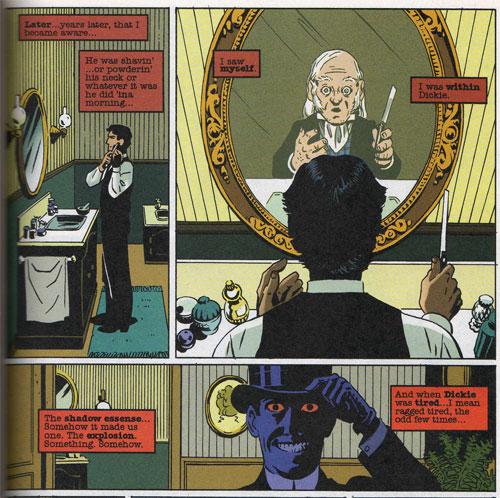
This was a very clever device on Robinson’s part to explain away the varied characterizations of the Shade over the years, in which sometimes he’d be a deadly serious world-conquering type, and other times he’d be driving Addams-Family-looking “Shademobiles.”
It might seem like a bit of a cheat introducing a new character as the villain of the piece this late in the game, but Robinson does such a great job of revealing the backstory and so quickly and sharply defining Culp’s character (such as having Culp waver between his natural Cockney accent and his predilection to speak French to make himself sound more intelligent, just for the simplest example) that it seems completely acceptable. It also helps that Robinson reveals a callback he’d planted in the series way back during Jack’s adventure at the carnival, when Rene, the somehow lobotomized dwarf genius billed as the “Pocket Encyclopedia,” mumbled mindlessly about a “bad dwarf.” Here we see Rene’s attempt to extort Culp, and how it went badly for him:
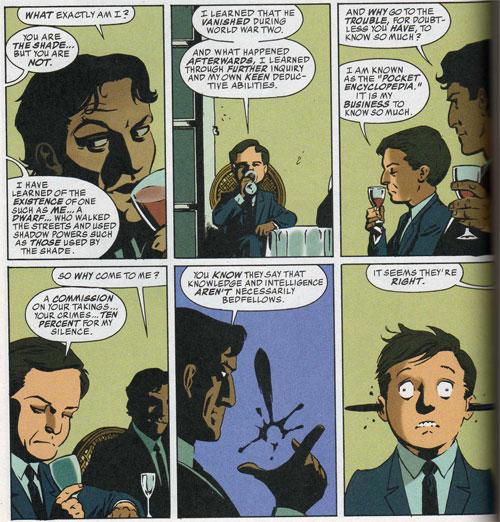
When you see a bit of foreshadowing laid down some sixty issues in advance, it certainly goes a long way toward making the eventual reveal seem a fair one.
STARMAN #67 picked up the storyline in the present where it had left off, with the revelation of Culp’s true nature and an overwhelmed Jack succumbing to the Culp’s forces. Culp continues the broadcast where the Shade left off, and is about to end it with the execution of Jack Knight:

That is, until some unexpected help arrives, thanks to a promise made millions of miles away…

Also swooping to the rescue is the Black Condor, who manages to free Mikaal while Jack rushes to find Sadie.
Jack and Sadie are finally united, and Jack wisely decides that discretion is the better part of valor. Jack, Mikaal, Adam Strange, Black Condor, Phantom Lady, Sadie and Clarence, Matt, Hope and Mason O’Dare retreat to regroup and plan their next move.

And by the way, let’s not overlook Peter Snejbjerg’s excellent work on the art in this story. Inking his own work, he’d really come into his own. It’s as dark and moody as Harris’ work, with his own looser, more cartoony style not taking away one whit from the realism. Snejbjerg had by this point completely made the series his own.
Getting back to the story, elsewhere in the Opal, Ted Knight, having suffered radiation burns in his most recent battle with Dr. Phosphorous, was looking to confirm his darkest suspicions:
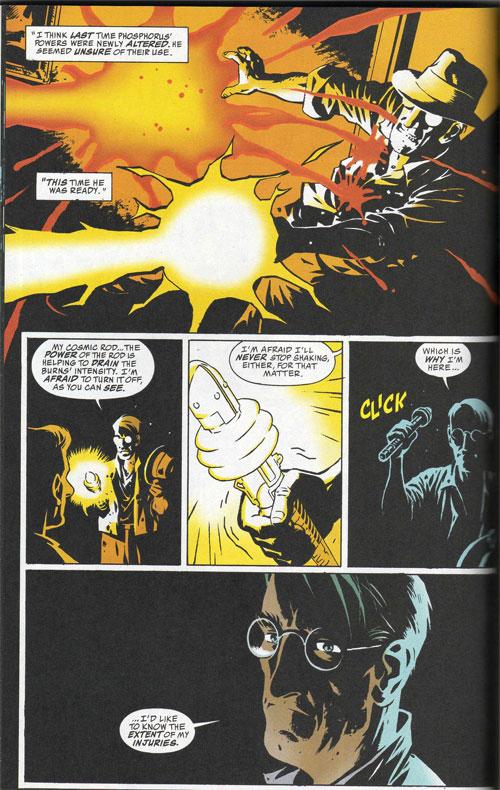
And finally, two of Culp’s goons left guarding the corpse of Bobo Bennetti receive a most unexpected surprise:

Once again, I’m going to dispense with the details for the second half of “Grand Guignol,” as we’re only at the halfway point, and there are so many twists and turns and revelations yet to come (as well as a most unexpected return), it would be a shame to deny anyone interested the pleasure of discovering them for themselves. However, I will have to spoil a couple of plot points from the climax in order to discuss the series from this point on; I’ll try to do so as obliquely as possible. At the story’s end, Jack is finally reunited with his son Theo, whom he’d never even seen before; however, the moment is bittersweet, as at practically the same time, Jack has to say goodbye to his father, who’s about to sacrifice his life to save Opal City. There’s just time enough for a few precious words:
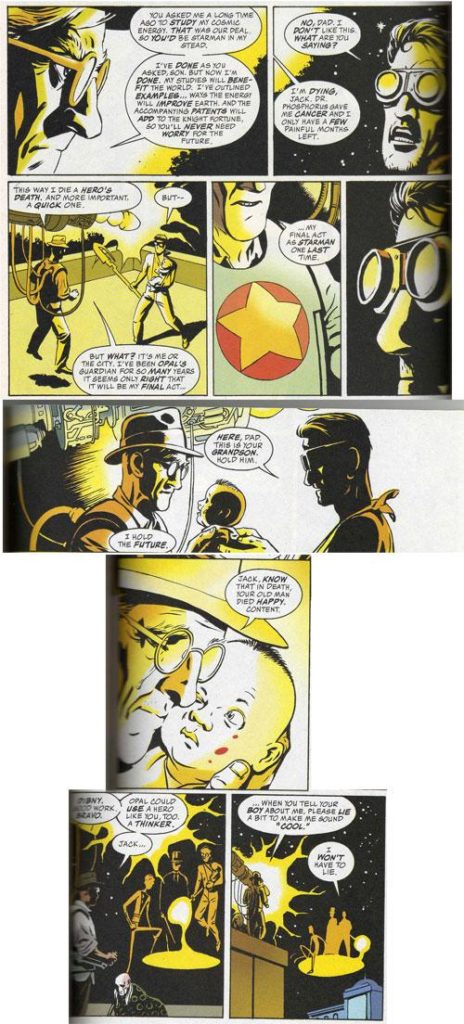
And Jack is left alone with a final thought:
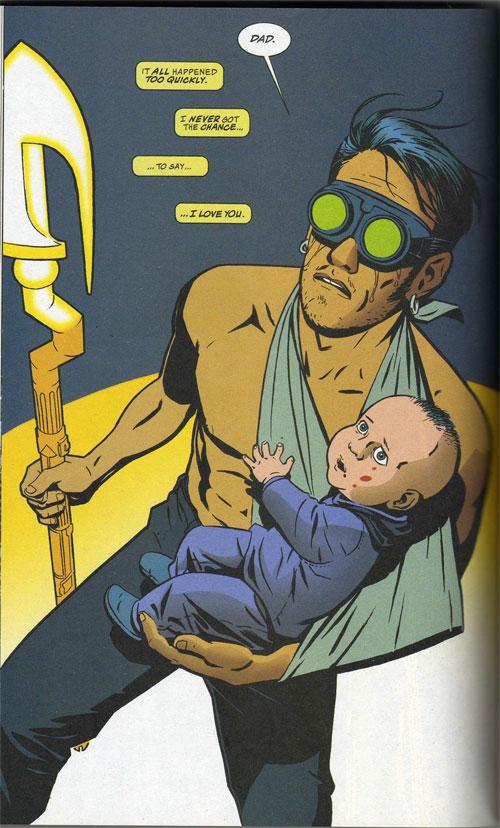
“Grand Guignol” might not be the best STARMAN story arc, but it’s damned close, up there in the same league as any of the Robinson /Harris collections. The way Robinson manages to close up the seemingly countless subplots he’d woven through the entire length of the series, and do so in a compelling, gripping and dramatic narrative — it’s a wonder to behold. And Snejbjerg shows off perhaps the best work of his career in these 12 issues.
Where to go from here? Well, there was still one more grand adventure for Jack to go on, not to mention a long-awaited reunion with his brother David. Come on back next week and I’ll tell you all about it.

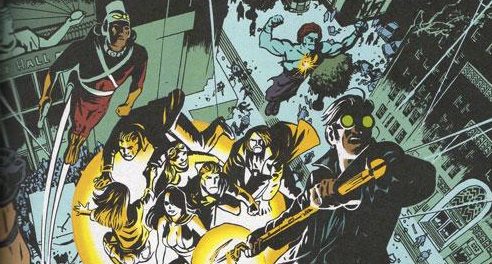
Comments are closed.